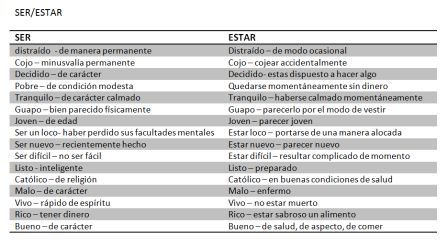Special Course of the aula virtual: The verbs ser and estar in Spanish
The tenses in Spanish is not a piece of cake. It's one of the topics that foreigner students find hard.
It's not easy to learn how to conjugate and how to avoid making mistakes when speaking. Once learnt how to conjugate you also have to learn how to use it properly and in the right contexts.
Down here we present you a smallguide on how to use the verbs ser and estar and it's differences.
Remember that at the Instituto Hemingway we created a distant course on the verbs ser and estar that words, according to the level, the most interesting contrasts and we give you the keys to improve it.
The difference between SER and ESTAR
SER
· Expresses the fact of 'existing', permanent features: ser o no ser, he ahí la cuestión // Soy Ana
· Physical and moral: es alto, moreno
· The origins of a person: soy de Bilbao
· The professions, the materials: soy profesor // la mesa es de madera
· Nationalities, religions, social classes: soy francés, católico, burgúes
· Expresses how a person is: es una persona encantadora
· Expresses where a place is: ¿donde es la boda? // La fiesta es en el bar
· Expresses thoughts: es verdad // es una buena idea
· Prices: ¿cuanto es?
· Time, day, seasons, year: ¿que hora es? // son las tres // hoy es domingo // es primavera
ESTAR
· Expresses how someone feels: está enfermo // está de mal humor // estoy bien // estan enfadados
· Indicates the 'staying in a place': estaba en casa // estoy de pie // estamos en Madrid
· Not permanent feature: está estropeado
· Indicates the presence and absence: estoy aqui // ya no está
· Indicates opinion or intention: está a favor // estoy por marcharme
· Indicates facts that have not concluded/finished yet: la casa está por hacer
· Indicates results: la comida ya está lista
· Changeable prices: ¿a cuanto están las manzanas (hoy) ?
· Dates: estamos a 25 de abril // estamos a viernes // estamos en verano
We hope that these little notes can help an motivate you a little bit. The next article will be on the differences between the different tenses in Spanish.
Yo amo is a present tense, yo amé is a past tense, yo amaré is a future tense and 'amar sin ser amado es tiempo perdido' (loving without being loved is wasted time). Can you see the difference?



 English
English Español
Español Deutsch
Deutsch Français
Français Italiano
Italiano Ру́сский
Ру́сский 

